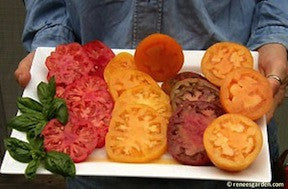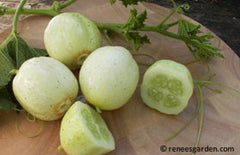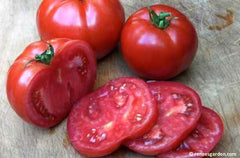
Heirlooms and Hybrids – What's Best for the Home Garden
|
|
All Seeds with Type |
|
All heirloom varieties are open pollinated, but not all open pollinated varieties can be considered heirlooms. Unfortunately the definition of “heirloom” has been somewhat of a moving target recently, but, generally; it means a variety, that is at least 50 years old, and that has been preserved and kept true in a particular region. So, for example if a particular kind of open pollinated pepper has been grown in Vermont or Maine for 5 or 6 generations and seed has been selected and saved by local growers and gardeners, it would be considered an heirloom variety. Obviously, heirloom varieties have been saved because they have some real virtues. The classic examples are heirloom tomatoes which often have superior flavor, color or texture for home garden situations but lack the holding ability, disease resistance or early maturity, etc., that would make them commercially viable. Seed saving organizations, specialty seed companies and home gardeners have been the agents that have kept heirloom varieties in existence over time, as larger seed companies generally focus on varieties (both O.P. and F-1) with commercial qualities. Fortunately in the last few years the popularity of heirlooms like Mortgage Lifter, Brandywine, and Marvel Stripe tomatoes has been growing rapidly, and some seed producing companies have started to make them available to home garden seed sellers once again. I think that both hybrid and open pollinated/heirloom varieties deserve a legitimate place in any home garden. Hybrids can offer uniform fruit often with superior disease resistances, reliable productivity and a particular maturity range. So, if I garden in an area that has a very short season with serious soil nematodes, I can choose a tomato hybrid developed to produce ripe fruit early and whose plants resist nematodes. If I garden in containers, I look for F-1 hybrids bred to grow into a short spreading bush with concentrated harvests. With tomatoes, it is often said that F-1 hybrids lack flavor, but that depends on which ones are planted. It’s true that many commercial tomato varieties have not been bred with top flavor as a priority in the USA. But many hybrids bred for home garden, like our hybrid beef steak, Big Beef, taste great, and there are many hybrids from Europe, where flavor has been more commonly a commercial breeding goal, that are quite delicious, like our Crimson Carmello, which was bred in France. Brassica family F-1 hybrids like our All Seasons broccoli, are a first choice in my garden because they are much more resistant to pests, disease, and weather fluctuations, and have been bred to be space saving and compact. 
One of my favorites is Lemon cucumbers. This 100+ year old heirloom variety effortlessly produces loads of fruit just the size and shape of pale colored lemons. They have a mild sweet flavor, crisp texture and thin skins, and are dual purpose: perfect for eating fresh or pickling. I also love planting a rainbow of tomatoes, so by choosing heirlooms, I can go way beyond ordinary red tomatoes and grow big, juicy orbs that ripen up to yellow, orange, pink, bicolored, cream or even purple/black! All have colorful histories and while they may not produce as plentifully or as reliably as F-1 red slicers, I wouldn’t be without them every summer. |
|
|
All Seeds with Type |
|
All heirloom varieties are open pollinated, but not all open pollinated varieties can be considered heirlooms. Unfortunately the definition of “heirloom” has been somewhat of a moving target recently, but, generally; it means a variety, that is at least 50 years old, and that has been preserved and kept true in a particular region. So, for example if a particular kind of open pollinated pepper has been grown in Vermont or Maine for 5 or 6 generations and seed has been selected and saved by local growers and gardeners, it would be considered an heirloom variety. Obviously, heirloom varieties have been saved because they have some real virtues. The classic examples are heirloom tomatoes which often have superior flavor, color or texture for home garden situations but lack the holding ability, disease resistance or early maturity, etc., that would make them commercially viable. Seed saving organizations, specialty seed companies and home gardeners have been the agents that have kept heirloom varieties in existence over time, as larger seed companies generally focus on varieties (both O.P. and F-1) with commercial qualities. Fortunately in the last few years the popularity of heirlooms like Mortgage Lifter, Brandywine, and Marvel Stripe tomatoes has been growing rapidly, and some seed producing companies have started to make them available to home garden seed sellers once again. I think that both hybrid and open pollinated/heirloom varieties deserve a legitimate place in any home garden. Hybrids can offer uniform fruit often with superior disease resistances, reliable productivity and a particular maturity range. So, if I garden in an area that has a very short season with serious soil nematodes, I can choose a tomato hybrid developed to produce ripe fruit early and whose plants resist nematodes. If I garden in containers, I look for F-1 hybrids bred to grow into a short spreading bush with concentrated harvests. With tomatoes, it is often said that F-1 hybrids lack flavor, but that depends on which ones are planted. It’s true that many commercial tomato varieties have not been bred with top flavor as a priority in the USA. But many hybrids bred for home garden, like our hybrid beef steak, Big Beef, taste great, and there are many hybrids from Europe, where flavor has been more commonly a commercial breeding goal, that are quite delicious, like our Crimson Carmello, which was bred in France. Brassica family F-1 hybrids like our All Seasons broccoli, are a first choice in my garden because they are much more resistant to pests, disease, and weather fluctuations, and have been bred to be space saving and compact. 
One of my favorites is Lemon cucumbers. This 100+ year old heirloom variety effortlessly produces loads of fruit just the size and shape of pale colored lemons. They have a mild sweet flavor, crisp texture and thin skins, and are dual purpose: perfect for eating fresh or pickling. I also love planting a rainbow of tomatoes, so by choosing heirlooms, I can go way beyond ordinary red tomatoes and grow big, juicy orbs that ripen up to yellow, orange, pink, bicolored, cream or even purple/black! All have colorful histories and while they may not produce as plentifully or as reliably as F-1 red slicers, I wouldn’t be without them every summer. |




